
Duct tape is cloth- or scrim-backed pressure-sensitive tape, often coated with polyethylene. There are a variety of constructions using different backings and adhesives, and the term 'duct tape' has been genericized to refer to different cloth tapes with differing purposes. A variation is heat-resistant foil tape useful for sealing heating and cooling ducts, produced because the adhesive on standard duct tape fails and the synthetic fabric reinforcement mesh deteriorates when used on heating ducts.
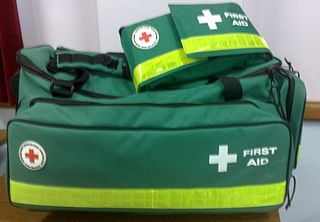
A first aid kit or medical kit is a collection of supplies and equipment used to give immediate medical treatment, primarily to treat injuries and other mild or moderate medical conditions. There is a wide variation in the contents of first aid kits based on the knowledge and experience of those putting it together, the differing first aid requirements of the area where it may be used, and variations in legislation or regulation in a given area.
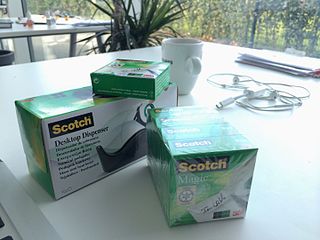
Scotch Tape is a brand name used for pressure-sensitive tapes developed by 3M. It was first introduced by Richard Drew, who created the initial masking tape under the Scotch brand. The invention of Scotch-brand cellulose tape expanded its applications, making it suitable for sealing packages and conducting item repairs. Over time, Scotch Tape has been utilized in various industries and households for its diverse adhesive solutions.
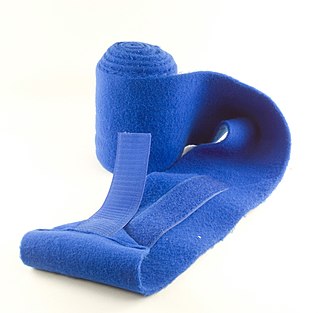
Polo wraps or exercise bandages are bandage-style leg protectors for horses. Made of fleece or elastic material, they are wound around a horse's legs from the fetlock to the knee or hock. They can be quite stretchy compared to other bandaging materials, and are used mainly for protection during ridden work, longeing, and turnout. They are often used as an alternative to boots.
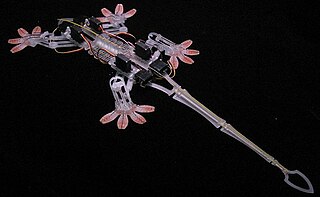
Synthetic setae emulate the setae found on the toes of a gecko and scientific research in this area is driven towards the development of dry adhesives. Geckos have no difficulty mastering vertical walls and are apparently capable of adhering themselves to just about any surface. The five-toed feet of a gecko are covered with elastic hairs called setae and the ends of these hairs are split into nanoscale structures called spatulae. The sheer abundance and proximity to the surface of these spatulae make it sufficient for van der Waals forces alone to provide the required adhesive strength. Following the discovery of the gecko's adhesion mechanism in 2002, which is based on van der Waals forces, biomimetic adhesives have become the topic of a major research effort. These developments are poised to yield families of novel adhesive materials with superior properties which are likely to find uses in industries ranging from defense and nanotechnology to healthcare and sport.

Bondage tape is a 2-to-3-inch-wide and 0.0051 in-thick (0.13-millimetre) strip of thin plastic material that adheres only to itself, without any adhesive; it is typically intended to be used in erotic bondage. Since it does not stick to the hair or skin, a bottom can be tightly bound or gagged without causing harm when the tape is removed.

There are many aspects to horse management. Horses, ponies, mules, donkeys and other domesticated equids require attention from humans for optimal health and long life.
A traction splint most commonly refers to a splinting device that uses straps attaching over the pelvis or hip as an anchor, a metal rod(s) to mimic normal bone stability and limb length, and a mechanical device to apply traction to the limb.
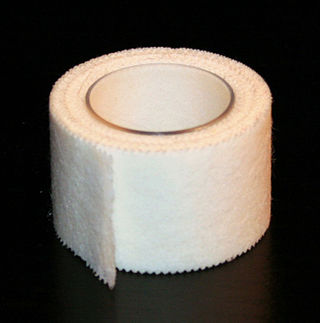
Surgical tape or medical tape is a type of pressure-sensitive adhesive tape used in medicine and first aid to hold a bandage or other dressing onto a wound. These tapes usually have a hypoallergenic adhesive which is designed to hold firmly onto skin, dressing materials, and underlying layers of tape, but to remove easily without damaging the skin. They allow air to reach the skin ("breathable"). Some breathable tapes such as kinesiology tape, and other elastic bandages with adhesive are made of cotton. Surgical tape is often white because it contains zinc oxide, which is added to help prevent infections. Tapes made of porous material, such as 3M Micropore, are widely used.

A hand wrap or wrist wrap is a strip of cloth used by boxers to protect the hand and wrist against injuries induced by punching. It is wrapped securely around the wrist, the palm, and the base of the thumb, where it serves to both maintain the alignment of the joints, and to compress and lend strength to the soft tissues of the hand during the impact of a punch.

Breast binding, also known as chest binding, is the flattening and hiding of breasts with constrictive materials such as cloth strips or purpose-built undergarments. Binders may also be used as alternatives to bras or for reasons of propriety.

Buddy wrapping, also called neighbour strapping or buddy taping, is the act of bandaging a damaged or particularly a fractured finger or toe together with a healthy, uninjured one. The bandage or medical tape is usually stiff, not allowing the digits to move; the healthy digit acts as a splint, keeping the damaged one in a natural position for healing. Rest plays a major role in the healing process. Buddy wrapping may also be used for sprains, dislocations, and other injuries.

An Unna’s boot is a special gauze bandage, which can be used for the treatment of venous stasis ulcers and other venous insufficiencies of the leg. It can also be used as a supportive bandage for sprains and strains of the foot, ankle and lower leg. The gauze is impregnated with a thick, creamy mixture of zinc oxide and calamine to promote healing. It may also contain acacia, glycerin, castor oil and white petrolatum.

An elastic bandage is a "stretchable bandage used to create localized pressure". Elastic bandages are commonly used to treat muscle sprains and strains by reducing the flow of blood to a particular area by the application of even stable pressure which can restrict swelling at the place of injury. Elastic bandages are also used to treat bone fractures. Padding is applied to the fractured limb, then a splint is applied. The elastic bandage is then applied to hold the splint in place and to protect it. This is a common technique for fractures which may swell, which would cause a cast to function improperly. These types of splints are usually removed after swelling has decreased and then a fiberglass or plaster cast can be applied.
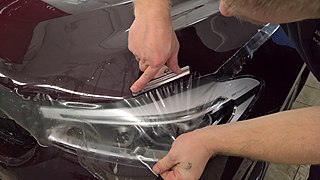
Paint protection film is a thermoplastic urethane often self-healing film applied to painted surfaces of a new or used car in order to protect the paint from stone chips, bug splatters, and minor abrasions. This film is also used on airplanes, RVs, cell phones, electronics, screens, motorcycles, and many other areas. Paint protection film is OEM approved by virtually all car manufacturers.
Tape or Tapes may refer to:

Elastic therapeutic tape, also called kinesiology tape or kinesiology therapeutic tape, Kinesio tape, k-tape, or KT is an elastic cotton strip with an acrylic adhesive that is purported to ease pain and disability from athletic injuries and a variety of other physical disorders. In individuals with chronic musculoskeletal pain, research suggests that elastic taping may help relieve pain, but not more than other treatment approaches, and no evidence indicates that it can reduce disability in chronic pain cases.

A shipping bandage, shipping boot, or shipping wrap, is a type of stable bandage or boot used on the lower legs of a horse to protect the animal while travelling in a horse trailer or other conveyance. The bandage starts just below the knee or hock, and ends at the floor, protecting the cannon bone, tendons of the lower leg, fetlock, pastern, coronet, and heels of the horse. Some boot designs extend slightly above the knee and hock, offering protection to the joints in the event the horse bumps its upper legs on the sides of the trailer.

Athletic taping is the process of applying tape directly to the skin or over pre-wrap in order to maintain a stable position of bones and muscles during athletic activity. It is a procedure that uses athletic tape, attached to the skin, to physically hold muscles or bones at a certain position. This reduces pain and aids recovery. Taping is usually used to help recover from overuse and other injuries.
Self-amalgamating tape is a non-tacky silicone rubber tape that when stretched and wrapped around cables, electrical joints, hoses, and pipes combines or unites itself into a strong, seamless, rubbery, waterproof, and electrically insulating layer. Unlike many other polymers and fibers, it is heat-, sunlight-, and weather-resistant. This type of tape is also described, particularly in the United States, as "self-fusing", or "self-vulcanizing". In the US Air Force it is called centerline tape due to a colored line running down the center used to assist with even wrapping. It is also called "F4", "tommy", "rescue", "Tape 69", "magic tape", ToolMonks Tape, and "fix-it tape".

















